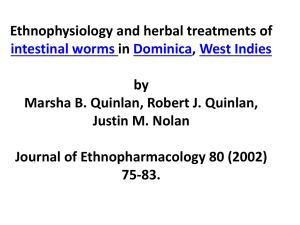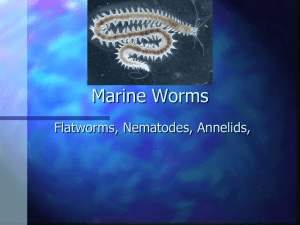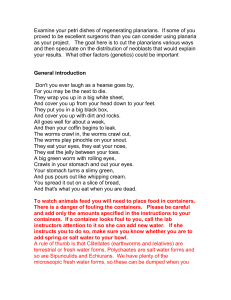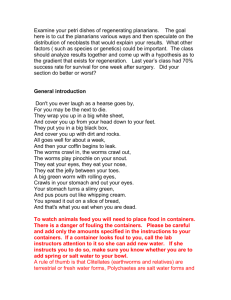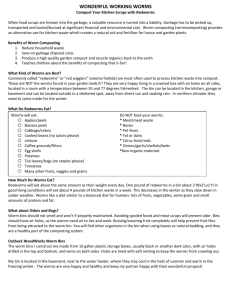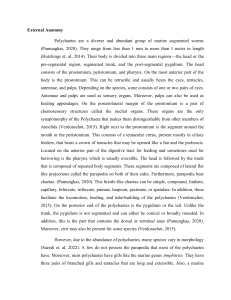Annelids 2
advertisement
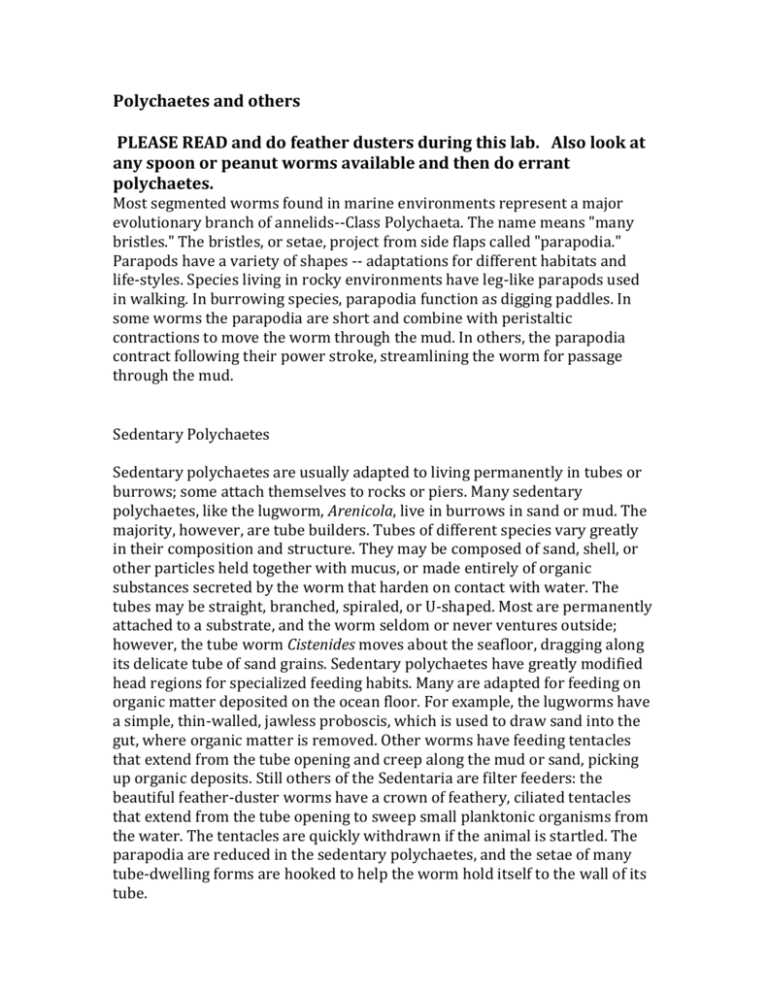
Polychaetes and others PLEASE READ and do feather dusters during this lab. Also look at any spoon or peanut worms available and then do errant polychaetes. Most segmented worms found in marine environments represent a major evolutionary branch of annelids--Class Polychaeta. The name means "many bristles." The bristles, or setae, project from side flaps called "parapodia." Parapods have a variety of shapes -- adaptations for different habitats and life-styles. Species living in rocky environments have leg-like parapods used in walking. In burrowing species, parapodia function as digging paddles. In some worms the parapodia are short and combine with peristaltic contractions to move the worm through the mud. In others, the parapodia contract following their power stroke, streamlining the worm for passage through the mud. Sedentary Polychaetes Sedentary polychaetes are usually adapted to living permanently in tubes or burrows; some attach themselves to rocks or piers. Many sedentary polychaetes, like the lugworm, Arenicola, live in burrows in sand or mud. The majority, however, are tube builders. Tubes of different species vary greatly in their composition and structure. They may be composed of sand, shell, or other particles held together with mucus, or made entirely of organic substances secreted by the worm that harden on contact with water. The tubes may be straight, branched, spiraled, or U-shaped. Most are permanently attached to a substrate, and the worm seldom or never ventures outside; however, the tube worm Cistenides moves about the seafloor, dragging along its delicate tube of sand grains. Sedentary polychaetes have greatly modified head regions for specialized feeding habits. Many are adapted for feeding on organic matter deposited on the ocean floor. For example, the lugworms have a simple, thin-walled, jawless proboscis, which is used to draw sand into the gut, where organic matter is removed. Other worms have feeding tentacles that extend from the tube opening and creep along the mud or sand, picking up organic deposits. Still others of the Sedentaria are filter feeders: the beautiful feather-duster worms have a crown of feathery, ciliated tentacles that extend from the tube opening to sweep small planktonic organisms from the water. The tentacles are quickly withdrawn if the animal is startled. The parapodia are reduced in the sedentary polychaetes, and the setae of many tube-dwelling forms are hooked to help the worm hold itself to the wall of its tube. We have living representatives of the tube dwelling polychaetes. The Sabellids are commonly known as "fanworms" or "feather duster" worms due to a colorful appearance of a maroon or red-colored tentacular branchial crown. They are indirect deposit-feeders. They have no proboscis. While feeding they spread out their branchial crowns to trap suspended particles and to sweep with their long mobile palps picking up deposited material (filter-feeding). Only suitable sized particles are ingested while others are rejected at the mouth. The more primitive sabellids members making temporary mucus tubes and creep around actively. They move either forward or backwards and they have 2 pairs of eyes, one at the head and the other at the pygidium. Typical ones are tubiculous, relying entirely on suspended food particles and living in tough tubes lined with muco-protein and covered with mud, sand and general debris. The large ones never leave their tubes and are associated with shallow water but smaller ones are able to move around. and are common in deep seas. 1. Obtain a feather duster worm and place in a dish of sea water (Salt water only please). Allow it to acclimatize to its new environment. Study its feeding device under the stereoscope. A. Include a movie or several photographs of its filter feeding in your notebook. Worm in tube The particles that land on the grooves can be sorted with respect to size. 2. There may be other sedentary worms available for you to observe. Obtain photographs. and compare the morphology of at least one other specimen to the feather duster worms. Pay particular attention to the head, which will tell you how these animals feed. For example, some sedentary worms have long tentacles with groves on them. These act as the “feathers” of a feather duster worm. The food particles are moved along by cilia in these grooves toward the mouth. An example of another type of sedentary worm we may have in the lab. Spirorbis In this genus and in the family Spirorbidae all species live in permanent calcareous tubes cemented to algae, shells, or rocks. These have cemented themselves to our filter in the large 60-gallon tank. Obtain a few specimens of this microscopic worm and place them in a small Petri dish so they can acclimatize to their new conditions. Be prepared to watch them for a few minutes so you can see them unfurl their tentacular crown. Terrebellids or cirratulids (spaghetti (many feeding tentacles) or hair worms (one pair of feeding tentacles)) We have hair worms in our tank. You can have your instructor put some food in the tank and watch their feeding tentacles protrude in response . Some of these also came in with the Bryosoans. We will see if we can either scrap some off of our tank walls or see if those that came in with the bryozoans are still alive, so that you can crack the tubes and so see more of the external anatomy. Terebellids are very complex animals, and have a body that may be divided into three regions, a head, thorax, and abdomen. The head is specialized for feeding and respiration, the thorax for moving in the tube, and the abdomen for the digestion of food. Cirratulids have a much more uniform body than do the terebellids. Each segment looks much like the next, and while a head is present, the remainder of the worm’s body is not divided into sections. There is neither a thorax nor an abdomen. Additionally, the cirratulids found in aquaria do not live in tubes but are found living free in the sediments below the surface. Errant Polychaetes Errant polychaetes include actively crawling or swimming forms, which may, however, also spend time in burrows or crevices, or under rocks on the seashore. A familiar errant polychaete is the clamworm, Nereis, widely used as bait. Errant polychaetes swim, crawl over the ocean bottom, or tunnel through surface sediments. Many are predators on small invertebrates; some are scavengers. In most the first few body segments bear sensory projections called cirri, while the remaining body segments bear conspicuous leg like appendages called parapodia. The parapodia, along with undulations of the body, propel the worm in crawling and swimming; parapodia are tipped with bundles of setae, usually made of chitin. Most errant polychaetes have welldeveloped head regions, which bear eyes, sensory tentacles, and a specialized organ, the nuchal organ, thought to detect chemicals. The anterior end of the gut often forms a protrusible structure, the proboscis, sometimes equipped with strong chitinous jaws and used in feeding. The setae of some polychaetes, e.g., the tropical fireworm, are composed of calcium carbonate rather than chitin and are hollow. These brittle setae are easily broken off and contain a toxin that produces a painful reaction in humans. In the scaleworms, a series of overlapping scales form a covering over the animal's upper surface. In the sea mouse these scales are completely covered by long, slender, feltlike setae projecting from the parapodia. 3.. We will not know what representative of errant polychaetes we will have until we prep Wednesday night and see what our supply houses have sent us. We will also spend some time looking for representatives in our tanks. Generally errant polychaeates are unwelcomed guests in our tanks, and so we do not really encourage their presence. a. Please compare the overall locomotion, morphology and any anatomy that may be apparent to that seen in the earthworm or Lubirculus. Wear gloves when handing these specimens, may have hairs on their body that can irritate your skin. Obtain videos of any specimen in which you can clearly see circulation and locomotion. You can try feeding your specimens. Please remember to record your observations in your journal. Other annelids??? 4. Spoon worms. Echiurans were included in the Annelida until recently. Your textbook is very conservative and still includes them as class of Annelida. Even by those that consider them a separate phylum, they are still considered close relatives of the annelids. The body of an echiuran lacks annelid-type segmentation, but the distinctive free-swimming trochophore larval stages of echiurans and polychaetes are very similar. Your teaching instructor will set up the dish of spoon worms under the microscope. a. Every one should take time to watch these animals move and attempt to bury themselves again. b, If you are lucky they may feed for you. Try fish food first, but black worms or liver may also work. Watching that spoon unfold is a sight you will not forget. Please remember to record your observations in your journal. Spoon and peanut worms are animals you many never again encounter in your lives. 5. Peanut worms Sipuncula -- These animals, which are commonly called "peanut worms" because some have the general shape of shelled peanuts, are not particularly well studied. Only about 320 species have been formally described, all marine and mostly from shallow waters. While some (like the specimen of Sipunculus shown below) burrow into sand and mud, others (like this unidentified species from French Polynesia) live in crevices in rocks, or in empty shells. Still others bore into rock. For instance, sipunculans have no trace of important annelid characters such as segmentation and chaetae (bristles). The characters they do share with annelids (e.g. worm shape, introvert, trochophore larva) are not restricted to annelids and sipunculans, but are much more general. These animals are now placed in a separate phylum, but were once considered aberrant annelids. Now some believe they may even be more closely related to mollusks. a. Obtain a peanut worm and watch it move and feed. If possible take photographs or video its introvert. Please remember to record your observations in your journal. Spoonworm. Peanut worm.




